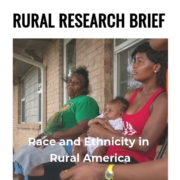HAC News Formats. pdf
December 12, 2012
Vol. 41, No. 24
• Congressional committee leaders announced • Streamlining HUD’s rental assistance again considered by Senate committee • Lead paint grants offered • Final rule issued for IHBG and Title VI loan guarantees • Input sought on Native American access to capital and credit • Downpayment sources for FHA mortgages addressed • HUD report shows homelessness rate statistically unchanged • Concentration of poverty growing in nonmetro areas, ERS reports • Rural poverty and housing need persist, HAC report says • HAC honors six for rural housing work
December 12, 2012
Vol. 41, No. 24
CONGRESSIONAL COMMITTEE LEADERS ANNOUNCED. Key positions will change in the 113th Congress, which starts in January. On the House Financial Services Committee, Rep. Jeb Hensarling (R-TX) will be the new chairman and Rep. Maxine Waters (D-CA) will be the new ranking member (top Democrat). For the Appropriations Committee, Rep. Nita Lowey (D-NY) will be the new ranking member, while Rep. Harold Rogers (R-KY) continues as chairman. Some House subcommittee leadership spots and Senate positions will also change but have not yet been announced. The HAC News will provide further updates as available.
STREAMLINING HUD’S RENTAL ASSISTANCE AGAIN CONSIDERED BY SENATE COMMITTEE. The Senate Banking, Housing and Urban Affairs Committee held a second hearing December 11 titled “Streamlining and Strengthening HUD’s Rental Housing Assistance Programs.” The first hearing on this subject was held in August.
LEAD PAINT GRANTS OFFERED. Applications are due February 4 for HUD’s Lead-Based Paint Hazard Control Grant and Lead Hazard Reduction Demonstration Grant programs, subject to congressional appropriation of program funds for FY13. States, counties, tribes, and other local governments are eligible, and funds can be used in owner-occupied or rental housing. Contact Michelle M. Miller, HUD, 202-402-5769.
FINAL RULE ISSUED FOR IHBG AND TITLE VI LOAN GUARANTEES. Changes in the regulations reflect consensus decisions by HUD and tribal representatives in a negotiated rulemaking process and implement changes enacted in several statutes, including the 2008 NAHASDA reauthorization act. Contact Rodger J. Boyd, HUD, 202-401-7914.
INPUT SOUGHT ON NATIVE AMERICAN ACCESS TO CAPITAL AND CREDIT. The CDFI Fund requests comments from tribes and others on research about access to capital and credit in Native communities, updating a 2001 study. It hopes to provide a baseline of information on the subject and to identify barriers and provide options to address them. Comments can be submitted in writing or in webcast meetings on January 15 and 17. Contact CDFI Fund staff.
DOWNPAYMENT SOURCES FOR FHA MORTGAGES ADDRESSED. Comments are due January 4 on a regulation clarifying that state and local government programs that provide funds for all or part of homebuyers’ downpayments for FHA mortgages are exempt from statutory prohibitions on some sources of downpayment funds. Contact Millicent Potts, HUD, 202-708-2212.
HUD REPORT SHOWS HOMELESSNESS RATE STATISTICALLY UNCHANGED. Data collected in January 2012 shows the number of homeless people nationwide almost the same as in January 2011, although there were increases and decreases in some states, and homeless veterans declined by 7%. The 2012 Annual Homeless Assessment Report counts people in shelters, transitional housing, safe havens, and places not intended for human habitation. Data for every state and Continuum of Care are also posted.
CONCENTRATION OF POVERTY GROWING IN NONMETRO AREAS, ERS REPORTS. An analysis of American Com-munity Survey data by USDA’s Economic Research Service found that many counties with newly high poverty rates are adjacent to those that had high poverty rates in 2000. ERS’s findings are similar to HAC’s in Taking Stock (see next article below) and HAC’s accompanying poverty map; the two analyses were conducted independently and use different definitions of rural.
RURAL POVERTY AND HOUSING NEED PERSIST, HAC REPORT SAYS. HAC’s decennial analysis of data from the Census and other sources describes demographic changes such as growth in the elderly and Hispanic populations, economic challenges like the foreclosure crisis, and ongoing housing problems including high housing costs, homelessness, and housing quality issues. HAC also looked in depth at five high needs regions and populations including the colonias near the U.S.-Mexico border, Central Appalachia, the Mississippi Delta, Native American lands, and farmworkers. Taking Stock: Rural People, Poverty, and Housing in the 21st Century is free on HAC’s site or $30 from HAC, including shipping and handling.
HAC HONORS SIX FOR RURAL HOUSING WORK. At the National Rural Housing Conference last week, HAC presented the Skip Jason Community Service Award to John David, founder and director of the Southern Appalachian Labor School in West Virginia; Owyne Gardner, T&MA Regional Manager at Little Dixie Community Action Agency in Oklahoma; Al Gold, Executive Director of Community Resources and Housing Development Corporation in Colorado; and Patty Griffiths, Housing Program Manager for the Community Action Commission of Fayette County in Ohio. The Cochran/Collings Award for Distinguished Service in Housing for the Rural Poor went to Shirley Sherrod, founder of the Sherrod Institute in Georgia. Rep. Barney Frank of Massachusetts, retiring after more than 20 years in Congress, received the Henry B. Gonzáles Award.



 Housing Assistance Council
Housing Assistance Council